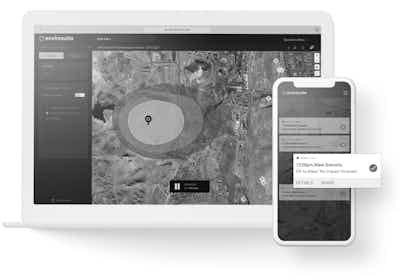Blasting is an essential part of most mining and quarrying activities.
It breaks up rock materials that are otherwise impossible to deal with effectively. It also makes for great imagery when, in the moments after detonation, clouds of dust explode into the air.
While the practice of blasting aims to minimise these pyrotechnic effects, they remain a part of the game and sometimes create problems.
What exactly happens in the surrounding air when a blast goes off? Explosive charges are generally detonated quite a way beneath the surface but nevertheless the tremendous heat and pressure generated in the sudden release of a blast’s chemical energy literally moves the earth.
Instantly, holes and cracks in the ground become escape routes for high speed releases of air that is packed with rock materials and gases that are produced in the process. This in itself dislodges more material and can result in sizeable rocks being thrown into the air: flyrock is a hazard that operators try to minimise but is always present.
Blast overpressure and the impact on nearby buildings
The sudden explosive expansion of air due to the energy release and heating of the air create shock and sound waves that radiate out from the blast ahead of any other effects. A phenomenon known as blast overpressure can result in loud bangs and even damage to buildings nearby. Under some weather conditions involving temperature inversions (warm layers) well above the ground, this energy can be reflected back to the ground kilometres away from the source.
The energy involved in blasts means that a portion of the rock is pulverised, reduced to dust. The dust cloud generated is propelled into the air: how far depends on the size and management of the blast as well as ground conditions.
Once in the atmosphere, the dust particles are at the mercy of gravity and the wind. Larger particles settle back to the ground more quickly than finer ones, and some can carry with the wind and turbulent eddies kilometres from the blast site as the plume disperses. It is important for the operators to understand the wind conditions and whether anyone on or off site will be in the dust cloud’s path while concentrations remain problematic.
The risk from the dangerous toxic that gases blast fumes contain
Potentially more dangerous are the gases contained in the blast cloud, particularly nitrogen dioxide (NO2). This is a toxic orange-brown gas that is generated in the chemical reactions of the blast and is a real issue if the subsurface contains a lot of moisture. It is critical that worker safety and community health is not compromised by the NO2 plume: unfortunate events do sometimes happen though.
For all these reasons mine and quarry owners, workers, regulators and nearby communities have a strong interest in ensuring that blasts are well managed to minimise the risks of adverse effects.
Envirosuite has been working with extractive industries for some years now with its Blasting solution that gives operators key predictions and alerts about the expected locations and size of overpressure, fume and dust impacts well ahead of time. This has allowed users to demonstrate the use of best practice, to avoid potential problem blasts and more efficiently allocate resources.

Envirosuite's Blast Management Solution
